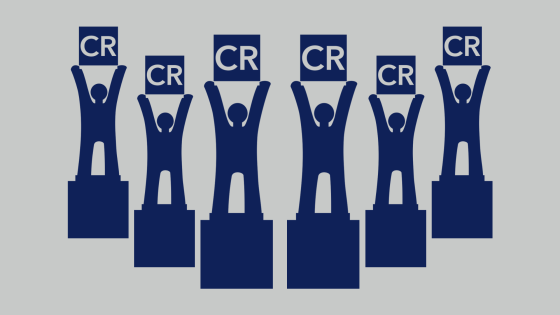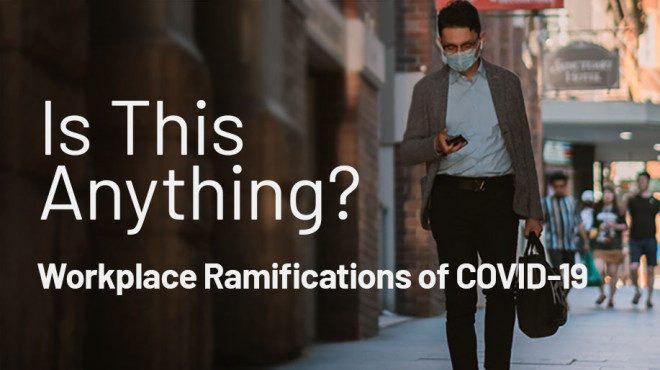Guest Blog: David Brown
Change can often seem to move at a glacial pace, but in 2020, the world changed seemingly in an instant. Our customers were already more mobile, more cloud-based, and more connected, but in the wake of COVID-19, some conventions were shattered, and new ones were established. While coronavirus may pass, many of the changes we are seeing may be permanent. Which changes will affect our business models and service offerings? Which ones will be temporary and which ones are here to stay?
When David Letterman hosted “Late Night with David Letterman,” he had a segment called “Is This Anything?” To start this segment, the stage curtain would lift, and behind it would be some jugglers, hula-hoopers, jump-ropers, or unicycle riders performing in the midst of pyrotechnics, bubbles, or some other busy spectacle. After 10 to 15 seconds, the curtain would be lowered and Letterman and Paul Shaffer would discuss “Is this anything?” Sometimes they decided that what they saw was indeed “something” and other times, not so much. In our industry, we have to confront the changes we see and decide for ourselves, “Is this anything?”
To be clear, this article is not questioning the significance of the pandemic. COVID-19 is a historic event that has impacted the entire world in more ways than we can realize today. The impacts will be widespread and far-reaching. There will be short-term, knee-jerk reactions and long-term transformation in how people work. Here are some of the most prominent conversation topics in print management and fleet management software space right now.
Mobile work
When COVID-19 essentially forced everyone out of the office in early March, it was a wakeup call to some companies that had not embraced remote work. Businesses everywhere scrambled to equip their teams to work for extended periods away from the office. Prior to March, many employers were OK with employees working remotely now and then. Other companies embraced remote workers as part of their workforce along with office-based employees. Now, everyone had to do it for the foreseeable future. There was no choice. What would the response be?
Overnight, everyone with a LinkedIn account was a thought leader and potential “work from home” mentor to their clients or colleagues. While I’m sure many were well-intentioned, other posts were cringe-worthy for their self-promotional content, much of which was of the Captain Obvious variety. Most individuals already knew how to take their laptop home, connect to Wi-Fi, and continue working.
The big takeaway on mobile work is the validation of having a workforce that can work from anywhere — not just the office. The cat is now out of the bag: many in professional roles can be just as efficient or even more efficient working outside the office — much to the disappointment of micromanagers everywhere. While this may be obvious to most, it has been far from universally accepted until now. There was always the old school of thought that would be repeated ad nauseam when anyone suggested a work-from-home or remote work program: “Our team functions more efficiently in a centralized environment” or “Our people work better in the office.” While that idea might have merit, often it was just another way of saying “We can monitor their work when they’re in the office.” Now that nearly all office workers are on their fifth month working from home and work is getting done, having a mobile workforce is not only viable but necessary. Is this anything? Yes. Because of COVID-19, employers that were previously reluctant to embrace work-from-home or work-anywhere ideologies have had their hands forced. They had to embrace it or cease operations.
What does it mean for managed print providers to provide services to companies that now have a 100% remote workforce during quarantine, and what will it mean as COVID-19 restrictions ease and offices reopen with more fluid policies that allow employees to work from home? Yes, this is something. And it has the potential to be significantly influenced by another change — attitudes toward the spreading of germs.
Germ-consciousness and social distancing
Obviously, workers are now much more conscious and aware of the spread of germs and will be more intentional in their actions around contact with others. Prior to COVID-19, working through sickness and even going into the office feeling a little under the weather was not only commonplace but respected. It was often viewed positively as a sign of dedication to one’s work and team. Five months later, going to work sick would be viewed as an unconscionable act of recklessness.
Is this anything? Because of the viability of the mobile workforce, the necessity to protect coworkers and customers by staying home will outweigh the need to be present. It has been proven now that office workers can work remotely and maintain productivity. For the short term, it seems that most will err on the side of caution and work remotely unless feeling completely well. Will there be a relapse to complacency if we move past COVID-19?
Assuming companies continue reopening their offices, what will our customers’ return to the office be like, and to what degree will their day-to-day processes be affected? It could be business as usual, but the likelihood is that an entirely new set of behaviors will emerge. It is a given that to prevent the spread of illness, many more hours will be spent working outside the office than previously. How will life in the office be different?
Will companies forego the open “collaborative” spaces in favor of traditional offices? Will work environments be designed with the express purpose of combatting the spread of illnesses? Due to social distancing recommendations, will meeting rooms be larger and configured differently? How will workers interact with technology? Yes, most workers have their own workstations and phones, but what about the communal technology that is shared — multifunction devices, printers, scanners, etc. Will there be a push to move away from larger centralized MFDs in favor of smaller desktop devices to ensure that fewer people are touching the same surface? What restrictions will be placed on service providers? Will installation teams and service technicians be viewed as potential infection risks by end customers? It stands to reason that the ability to manage customers remotely with less onsite activity will have increased value. In the short term, workers in the office and especially installation and service technicians will have to take measures to reduce their own risk and the risk they pose to their customers. In the long term, how the current pandemic continues to impact our world and leave its mark will ultimately shape mindsets about the spread of germs (and by extension, illness) in the workplace.
Is this anything?
You may have noticed I’ve got more questions than answers. These topics are frequently turning up in many of my customer conversations and are likely surfacing in yours as well. Mobility, germs, and social distancing in the context of the workplace are going to be front and center for the foreseeable future. They are “something.” While we all may predict different outcomes or ramifications from COVID, the one thing we would probably all agree on is that it’s not yet clear what the far side of this pandemic looks like in terms of how we go to work and conduct business on a daily basis. That it will be different is already plain to see as we practice social distancing and grab another pump of hand sanitizer. How long and in what ways it will be different are not as clear. The only clear prediction is that things will definitely be different. I don’t know who first used the phrase, “These uncertain times,” but I hope they have the copyright.





